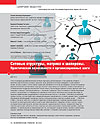Network Structures, the Matrix, and Chaperons. Practical Options and Organizational Innovations
This article is concerned with decentralized network structures. Emphasis is placed on their matrix, i.e. the system of ideological attitudes, values, myths, behavioral norms, and tacit knowledge that is exemplified by software development techniques in the networks of IT specialists. The knowledge exists at the level of the whole network and is not completely accessible to each individual network member. The advent of digital technology is currently giving a new impetus to the development of decentralized cooperative structures. Of paramount importance are the mechanisms of non-hierarchical behavioral coordination that operate in network structures. Special attention is to be given to psychological techniques that secure the dominance of group-level goals, values and creative processes over the individual behavioral trends of network members. Such techniques that involve subconscious brain modules can be facilitated by regulatory social structures, referred to as social chaperons. Promoting the chaperons’ optimal functioning and enhancing their soft guiding and stimulating influence could be the mission of a novel social institutions including the Committee for Promotion of Network Structures, the Research Institute for Network Structures, state-supported counseling bodies for network developers, and public network associations. These innovative state-level bodies should aim to (i) legalize the status of decentralized cooperative network structures, (ii) optimize their organization and (iii) harmonize their interaction with non-network structures such as centralized hierarchies, including the “President’s vertical” power structure and local bureaucratic structures, as well as quasi-market structures.



